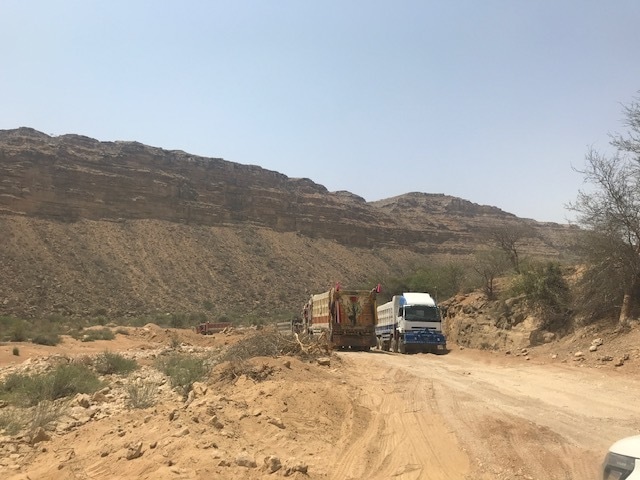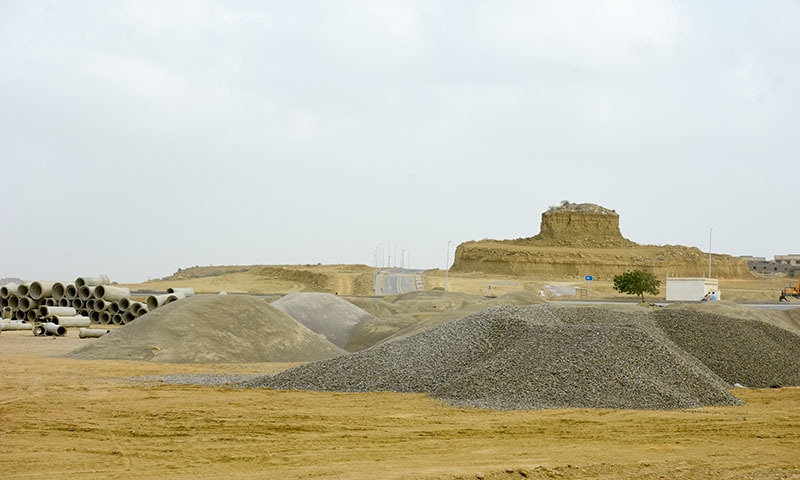The land mafia’s rackets: A disaster foretold
The concluding part of ‘Bahria Town & others: Greed unbound’ looks at unchecked sand mining & groundwater extraction in Malir & Jamshoro.
In a situation where the bottom line is what counts while the law is trampled underfoot, the land grab in Malir and Jamshoro has given wheels to a number of criminal enterprises in the area.
On a hot summer day in mid May, at least half a dozen dumpers were parked along the banks of Mole naddi, a seasonal stream that falls into the Malir river about 30 miles north of Karachi. Several excavators were scooping out huge amounts of river silt. One of the dumper drivers, Omar, came across for a chat. He told Dawn that some 65 dumpers make three round trips every day, 24 hours a day.
“Almost all the reti is for Bahria, although some goes into the city. Because of Ramazan, it’s a little quiet because many of the drivers here are from Swat and Shangla and they go home for Eid.”

A wide uncarpeted track has been especially created to transport sand and gravel dredged from the riverbed. It extends from Mole naddi all the way into Malir and Bahria Town Karachi (BTK). Even during Ramazan, within a 20-minute span, the Dawn team witnessed at least five dumpers going in the direction of BTK, their wheels raising clouds of dust in their wake.
According to Malik Asad Sikandar, the area’s powerful tribal chief, the sand mining is “completely legal and is being done by locals on the basis of leases [from the government]”.
However, as per the Sindh (Prohibition of Taking Minerals Including Reti (Sand) and Bajri From Any Land) Act 2003, no exception can be made or sanction can be given for such excavation “if it adversely affects the topography, archaeology, ecology and environment of that area”.
Influential locals, including the kumdar and other opportunists in the service of the land mafia, are making money hand over fist from various rackets in the area.
Sand and gravel mining here carries dire short- and long-term consequences. “All of this is the support area for Kirthar National Park,” said Rakhman Gul Palari, professor at Karachi University’s Sindhi department. “The park’s eco-system is all inter-connected. The wildlife sanctuaries, the game sanctuaries all depend on the area remaining in its natural state.”
Kirthar is Pakistan’s second largest wildlife sanctuary after Hingol. Chinkara gazelles, urials, hyenas and the rare Sindh ibex are among the many animals found there.
The sand and gravel mining has also devastated the farmers: sand slows down the flow of water, acting as a filter before the water seeps into the earth. Wholesale plunder of the riverbed disrupts that process, and the water table in large parts of Jamshoro and Malir has plunged to critical levels.
“We used to draw water from a depth of 40 or 50 feet; now it’s at 200 feet,” said Karim Burfat, who cultivates vegetables on a patch of land very close to Mole naddi. “A thick layer of sand covers everything. The crops get ruined and the grass that sustains the livestock becomes scorched.”
Read part 1 of this article: Bahria Town & others: Greed unbound
Fiefdoms built on sand
Resistance is futile: some who have tried to prevent the lifting of sand have been thrashed and thrown into the police lock-up.
While farmers like Karim are witness to their livelihoods withering away, influential locals, including the kumdar and other opportunists in the service of the land mafia, are making money hand over fist from the various rackets in the area.
Four years ago one of them worked at a provisions store; another used to sell sugar and flour at the Kathore bazaar in Malir; a third had a tailoring shop in the same market. These individuals, and several other kumdar now own dumpers and excavators, and have acquired buffalo farms, car showrooms, etc.
“People who didn’t own 10 goats ten years ago now have dumpers worth millions of rupees along with land cruisers, Vigos and whatnot,” said one of the villagers bitterly. “Many goths have no electricity, yet these men can afford to put up big solar panels on the roof of their homes. It’s creating a lot of resentment.”
One may well ask: where will this land grab end, and who will put a stop to it?
The sand and gravel mining racket is a real money-spinner. The contents of each dumper sell for Rs22,000 inside BTK (some dumpers go further afield but the biggest customer by far is the behemoth in the neighbourhood). From the total, the owners/kumdar make around Rs6,500 while the rest — minus fuel and maintenance expenses — goes to other influential ‘stakeholders’ up the hierarchy, including the police and allegedly the tribal chiefs.
The kumdar in the goth closest to deh Mole’s boundary with deh Bolari in Malir district also charges Rs800 per dumper as ‘zillabandi tax’ to allow the vehicles to cross over.
Meanwhile, the farmers whose small patches of agricultural land close to Mole naddi are dying for lack of water, are ‘compensated’ with Rs200 per dumper. One of them however, a wizened old man with betel nut stained teeth refuses to accept the pittance offered. “Is that the price for my destruction?” he fumed.
It is not only the sand and silt from the riverbed that is being gouged out to meet the insatiable construction demands in the area. One huge sand mining site also lies on the boundary between Malir and Jamshoro districts near BTK’s Sports City. Moreover, the natural landscape is being ruthlessly refashioned by Bahria to follow the BTK layout (and the sand produced as a result is also being used in construction): hills have been ground down and natural river courses truncated.

Squeezing the land dry
Construction also requires water, and a gargantuan project like BTK requires millions and millions of gallons of it. And that is where the area’s sub soil water is being diverted — despite Section 144 being in force against the extraction of water for commercial purposes in the adjoining Malir district.
The ban was imposed after the Sindh High Court in 2004 restrained Nestle Pakistan from setting up a water bottling plant in deh Chuhar, Malir. The verdict held that “once the process of extracting the water in such a huge quantity is allowed to operate, each day, each hour, and each minute water deposits in the aquifer would diminish rapidly and shall adversely affect the rights of plaintiffs to use the underground water according to their genuine needs which shall amount to an irreparable loss to them”.
If allowed to go ahead, the Nestle plant would have been only three kms from BTK as the crow flies. According to Gul Hassan Kalmati, central committee member of the Indigenous Rights Alliance Sindh and a well-known historian, anthropologist and writer, there are more than 200 submersible pumps in Malir, capable of drawing out 26,000,000 gallons of water in 24 hours.
Aside from these, say locals, another 25 or so are inside Bahria Town itself, steadily depleting the sub soil aquifer, the only source of water in the area for villages situated even miles away. (Of these, two were installed about ten years ago by the District Council Karachi to supply water to nearby goths on a non-commercial basis.)
The hydrant owners sell the water to various housing schemes in the area, but largely to BTK for its massive construction needs. This of course is another source of illegal earnings for the police, the kumdar and others.
The afore-mentioned second confidential progress report submitted by NAB to the apex court also questions how “the BTK project is getting millions of gallons of fresh/potable water inside BTK project for daily consumption and for mass scale construction”.
When asked how many villages in deh Mole alone are affected in one way or another by the land grabbing, water extraction, or sand mining — a group of locals begin to count off the goths on their fingers. They arrive at an estimate of at least 25.
Consider that state land in other dehs in district Jamshoro, including Hathal Buth, Uth Palan, Babar Band and Sari, is also being acquired in the same illegal way as that in deh Mole. One may well ask: where will this land grab end, and who will put a stop to it?
A morally bankrupt state
What is happening on the outskirts of Karachi is a perfect example of a morally bankrupt state.
Even as government functionaries break every law in the book to enrich themselves and their partners-in-crime in the establishment, they have done nothing for the people they claim to represent. Education and health facilities in Jamshoro’s taluka Thana Bhula Khan are virtually non-existent. “Any medical emergency such as a heart attack or a difficult delivery means certain death. Rarely can anyone get to a Karachi hospital in time,” said a local.
At night in particular, BTK is a savagely apt metaphor for the haves and have-nots in this saga.
Hardly anyone has taken up residence in this sprawling community so far, yet, come sunset, each road, each landmark is lit up. Even the replica Eiffel Tower overlooking BTK is illuminated. But villages dotting the surrounding areas, in which hundreds of people live, are shrouded in darkness.
For them, there is neither electricity, nor proper roads.
Some names have been changed for the sake of privacy.




